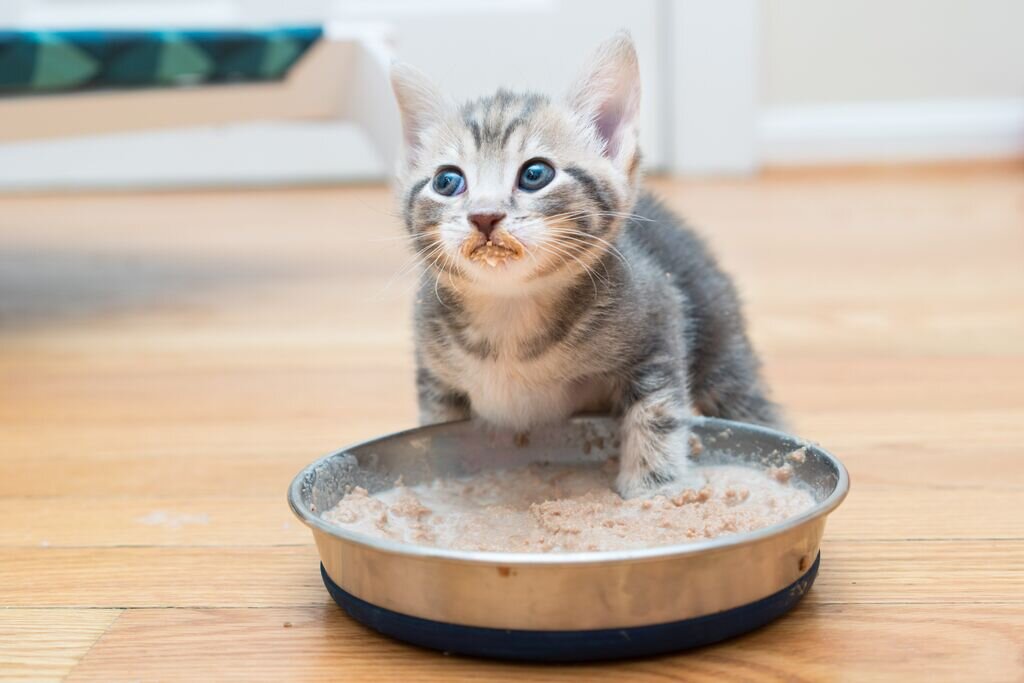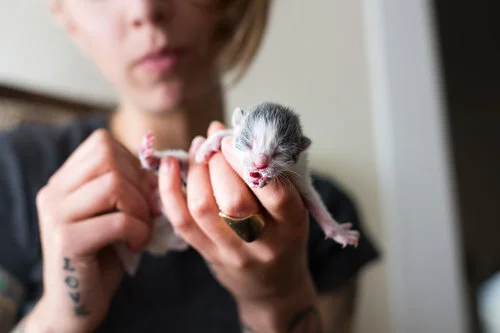Weaning Kittens
In this video, you’ll learn strategies for weaning kittens off of a bottle and on to solid foods.
When can a kitten safely eat on her own? Learn why it’s important to “meat them where they are.”
Weaning is the fun, messy adventure of helping a kitten transition from nursing (or bottle feeding) to eating solid food on her own! Kittens often need extra support during this time to help ensure they're receiving the proper nutrients in proper quantity, and to keep them on track for success and independence. Here's what you need to know about weaning:
1. Start at the Right Age
Kittens' bodies are very sensitive to premature weaning, so be careful about starting them too young. A kitten 0-5 weeks old should be nursing or bottle feeding. Around 5 weeks of age, the kitten's premolars will begin to emerge, indicating that she is likely ready to start trying out some meaty foods. However, some kittens may need a bit more time on the bottle due to health issues, or differences in weight or size. Use your best judgement and follow the kitten's lead to determine the appropriate age to wean. If you see any changes in the kitten's health or energy during this process, immediately step back to bottle feeding.
2. Get the Right Supplies
Pick up some wet kitten food, making sure that it says "kitten." Kitten food is higher in calories, fat and protein that the kitten needs to help grow big and strong. Wet food is the healthiest choice for kittens to start off with, as the moisture content will help them stay healthy and hydrated. However, some kittens may prefer dry food, and that’s okay as long as you choose a healthy kitten kibble. You'll also want to pick up some shallow food dishes so the kitten can easily access the food.
3. “Meat” Them Where They Are
The most important rule of weaning is not to rush—do things on the kitten’s timeline, not yours! Try offering the kitten some small bites of wet food on a finger, a spoon, or a tongue depressor, and see if they will accept it. If they’re interested in eating, see if they are able to access the food in a dish. Remember that this is a new skill for them, so many kittens will find it difficult to eat out of a dish for the first several days. No rush!
Once the kitten has eaten some solids, it’s time to supplemental feed with a bottle (or allow them to keep nursing with mom, if mom is present!) Supplemental feeding ensures that your kitten is getting all of the calories and nutrition she needs during this slow transition. There's no such thing as "tough love" for kittens, and if she isn't understanding how to eat yet, you'll still need to supplement to make sure she's staying healthy and well fed.
You may also choose to offer the kitten a slurry—a mix of formula and wet food, which is used to help transition the kitten from one food to the other. You may begin by just introducing a small teaspoon of wet food mixed with the formula, which allows the kitten to acclimate to the new proteins and flavors. As the kitten becomes more comfortable eating meat, you'll begin increasing the ratio so that there is more wet food present at each feeding.
Weigh the kitten throughout the weaning process. If her weight drops or steadies, you’ll need to supplement with a bottle, try a different method of eating, or scale back to kitten formula.
4. Fully Wean and Introduce Water
Once the kitten is confidently eating on her own, you can cease supplemental feeding—it's time to switch completely to solid foods! Be sure you're feeding a high quality food formulated for kittens, and monitor to ensure that there are no concerning changes in weight, behavior, or condition.
At this time, it's also appropriate to introduce water in a small, shallow dish. Never provide a large dish that can cause a safety hazard to a tiny kitten; keep your water dish to about 2 inches high. It's normal for kittens to struggle with water at first, but she should be drinking confidently within 1-3 days of introduction.
Check Out More Content From Kitten Lady






